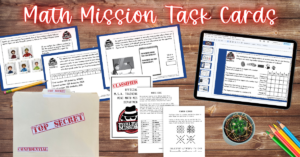The same hands
You ask a question to your class and a few hands shoot up in the air. They are the same hands that are raised nearly every time you ask a question, while the majority of the students sit hoping not to get called on. A couple of students shift uncomfortably in their seats, while a handful more stare blankly out the window. Can you relate to this? When I was teaching upper elementary, I always had a few kids I could count on to answer nearly any question; finding ways to get everyone more engaged was a constant challenge. I’d hear some groans every time a math worksheet was passed out. Group work wasn’t always much better as one or two of the group members ended up doing the majority of the work. Not every activity can be an exciting game or challenge, but a break from normal can help pull more students into the mix and increase student engagement.
A few years back, I found myself doing something I vowed I would never do; homeschooling my own kids. You see, I have a lot more patience with other people’s children than I do with my own. At least, I thought, with only three students, it would be easy to get everyone engaged. I was surprised to find my own kids taking on the same roles as I’d seen students do in the classroom. We needed to shake things up!
 Shaking up the Routine
Shaking up the Routine
Teachers have a repertoire of strategies for increasing engagement and student participation. Drawing popsicle sticks with students’ names (this can put a lot of pressure on students, but that is for another post), turning activities into games, putting facts to a beat for auditory learners, or mixing in physical activity to help kids focus are some common methods employed by teachers. There are many great activities out there to help increase student engagement. Educational escape rooms have burst onto the scene in the past few years, and are an excellent way to get students engaged.
Using Educational Escape Rooms to Increase Student Engagement
In recent years, educational escape rooms have become widely used in classrooms. With the increase of technology available in many classrooms, digital escape rooms have provided teachers with low-prep, easy to implement escape room options. These breakout games are a great way to get students more involved an interested in learning while practicing and reviewing standards-based skills as well. Here are some tips to help you increase student engagement using escape rooms in your classroom.
- Choosing or creating an escape room with an engaging backstory is essential for increasing student engagement. Teachers can set the stage with a sense of urgency, mystery, or suspense as they introduce the activity. My children’s favorite escape rooms are always the ones where they are trying to catch a criminal or crack a case. They become connected with the storyline and excited about solving the puzzles. I’ve created several “top secret mission” escape rooms complete with dossiers of the suspect students are after.
- Finding or making escape rooms with fun puzzles and ciphers will make the activities seem much less like worksheets and make them much more engaging. I’ve had teachers tell me that there students didn’t even realize they were completing so many standards-based skills because they were having so much fun decoding puzzles! Kids love ciphers and puzzles, and these types of activities provide additional ways for everyone to work as a team and get involved.
- Putting students into pairs or groups with mixed-ability levels is key. Escape rooms are great for encouraging cooperative learning. Many teachers have told me how surprised they are when their high-level students are stumped by an escape room puzzle, a student who often doesn’t perform as well is able to think outside of the box and solve the problem. One of my favorite things about watching students use escape rooms in the classroom is seeing that student who doesn’t have a lot of confidence be the one to figure out how to complete a puzzle. Their faces glow!

- Monitor the groups to make sure one person isn’t taking control of all of the puzzles. Assigning group roles can be helpful (clue reader, recorder, typer, etc). Having students take turns being in charge of the tablet or computer can also be helpful.
- Letting kids struggle is very important with escape rooms. They are meant to be challenging! It’s important to allow kids to have that aha moment, while also making sure that they don’t become too frustrated and give up. Many children are not used to struggling, and need to develop problem-solving skills and resilience. Escape rooms can help with this!
- If a group finishes earlier than the others, allow those children to become the game masters! Students love taking on the responsibility of providing hints, and they generally do a great job of not giving too much information out.
- Give the class a chance to debrief after completing an escape room challenge. You might see a few hands shoot up into the air that you don’t usually see when they are asked about completing the challenge.
Escape rooms are great to use in the classroom to help students practice and review skills before tests. Using escape room before holidays or school vacations is also great to keep kids engaged in learning during distracting times. Breakout games are also a great reward for students, even when they are educational and students are still working on reaching goals!
You’ll find tips and tricks for creating digital escape rooms throughout our blog. If you’re looking for math escape rooms for 2nd-7th grades that are already made, please visit our Great Classroom Escape store on Teachers Pay Teachers.
We’d love to hear about your experience using escape rooms to increase engagement in your classroom. Share your experiences in the comments!





